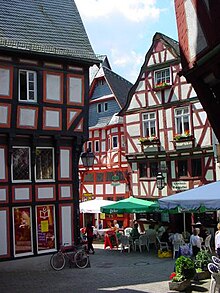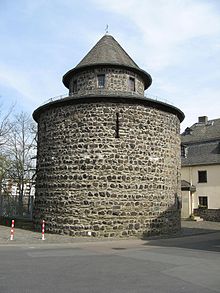Location

|
||
| Home | ||
|
Town |
LocationLimburg lies in western Hesse between the Taunus and the Westerwald on the river Lahn. The town lies roughly centrally in a basin within the Rhenish Slate Mountains which is surrounded by the low ranges of the Taunus and Westerwald and called the Limburg Basin (Limburger Becken). Owing to the favourable soil and climate, the Limburg Basin stands as one of Hesse's richest agricultural regions and moreover, with its convenient Lahn crossing, it has been of great importance to transport since the Middle Ages. Within the basin, the Lahn's otherwise rather narrow lower valley broadens out noticeably, making Limburg's mean elevation only 117 m above sea level. |
|
|
In 1150, a wooden bridge was built across the Lahn. The long-distance road from Cologne to Frankfurt am Main subsequently ran through Limburg. In the early 13th century, Limburg Castle was built in its current form. Shortly afterwards, the town passed into the ownership of the Lords of Ysenburg. In 1214, the community was granted town rights. Remains of the fortification wall from the years 1130, 1230 and 1340 with a maxiumum length of roughly one thousand metres indicate to this day the blossoming town's quick development in the Middle Ages. There is proof of a mint in Limburg in 1180. Mediaeval window at the back of the cathedral (peristyle)
One line of the Lords of Ysenburg resided from 1258 to 1406 at Limburg Castle and took their name from their seat, Limburg. From this line came the House of Limburg-Stirum and also Imagina of Isenburg-Limburg, German King Adolf's wife. The ruling class among the mediaeval townsfolk were rich merchant families whose houses stood right near the castle tower and were surrounded by the first town wall once it was built. The area of today's Rossmarkt ("Horse Market"), in which many simple craftsmen lived, was only brought within the fortifications once the second town wall was built. The inhabitants there, however, unlike the merchant élite, were accorded no entitlement to a voice in town affairs and were not allowed to send representatives to the town council. Nevertheless, they had to bear the main financial burden of running the town. Only in 1458 were they allowed to send two representatives to town council.    |
Saint George's Cathedral (Sankt-Georgs-Dom) built on the old monastery church's site, and also called Georgsdom, was consecrated in 1235. On 14 May 1289, a devastating fire wiped out great parts of the inner town, although these were subsequently rebuilt. One of the houses built at that time was the Römer 2-4-6, which is today one of Germany's oldest half-timbered houses. In 1337, Limburg's Jews were expelled from the town. Only in 1341 were they once again able to settle in the town, by royal decree. In 1344 a half share of the town was pledged to the Electorate of Trier, and in 1420, the town passed wholly into the ownership of Trier. This event, along with another town fire in 1342, the Black Death in 1349, 1356 and 1365, but above all the rise of the Territorial Princes, led to a gradual decline. In 1315 and 1346, the old stone Lahn Bridge was built (presumably in two sections). Limburg – extract from the Topographia Hassiae by Matthäus Merian 1655
Saint George's Cathedral in Limburg today
Old Town
Against the background of the German Peasants' War, unrest also arose among the townsfolk in 1525. After the Elector of Trier had demanded that the townsmen turn a Lutheran preacher out of the town, a board made up of townsmen who were ineligible for council functions handed the council a 30-point comprehensive list of demands on 24 May. It dealt mainly with financial participation and equality in taxation, trade and building issues with the merchant class. In the days that followed, these demands were reduced in negotiations between the council and the board to 16 points, which were likely also taken up with the Elector afterwards. On 5 August, however, Archbishop Richard ordered the council to overturn all concessions to the townsmen. Furthermore, a ban on assembly was decreed, and the ineligible townsmen were stripped of their right to send two representatives to council. In 1806, Limburg came into the possession of the newly founded Duchy of Nassau. In 1818 the town wall was torn down. In 1827 the town was raised to a Catholic episcopal seat. In 1866 the Duchy and with it Limburg passed to Prussia in the wake of the Austro-Prussian War. As of 1862, Limburg became a railway hub and from 1886 a district seat. In 1892, the Pallottines settled in town, but only the men; the women came in 1895. During World War I there was a major prisoner of war camp at Limburg an der Lahn. Many Irish members of the British Army were interned there until the end of the war and at one stage they were visited by the Irish republican leader Roger Casement in an attempt to win recruits for the forthcoming Irish rebellion. From 1919 to 1923, Limburg was the "capital" of a short-lived state called Free State Bottleneck (or Freistaat Flaschenhals in German) because it was the nearest unoccupied town to the Weimar Republic. |
The cabaret troupe "Thing", founded more than 25 years ago, moved after a short time from its initial home in the outlying centre of Staffel to the Josef-Kohlmaier-Halle, a civic event hall, where its stage can now be found in the hall's club rooms. The troupe is run by an independent acting club. On the programme are chanson, cabaret, literature and jazz as well as folk, Rock and performances by singer-songwriters. It makes a point of furthering young artists. Each month, three or four events are staged. The dedication of "Thing" was recognized on 6 December 2003 when the Kulturpreis Mittelhessen ("Middle Hesse Culture Prize") was awarded to it. Limburg Cathedral has a famous boys' choir, the Limburger Domsingknaben, although they are actually based at the "Musical Boarding School" in Hadamar just outside Limburg. MuseumsThe Katzenturm, formerly part of the town wall, today a navy museum
Fischmarkt
View through a gate near the Limburg cathedral treasury
In Limburg there are several museums. The most important are:
BuildingsOnly a few towns, like Limburg, have been able to keep a full set of nearly unscathed mediaeval buildings. The formerly walled town core between St. George’s Cathedral, Grabenstraße (a street marking the old town moat) and the 600-year-old Lahn Bridge thus stands today as a whole under monumental protection. The Altstadt ("Old Town") boasts a fine cathedral and is full of narrow streets with timber-frame houses, dating mainly from the 17th and 18th centuries. That's why it is located on the German Timber-Frame Road. |
||
BuildingsOnly a few towns, like Limburg, have been able to keep a full set of nearly unscathed mediaeval buildings. The formerly walled town core between St. George’s Cathedral, Grabenstraße (a street marking the old town moat) and the 600-year-old Lahn Bridge thus stands today as a whole under monumental protection. The Altstadt ("Old Town") boasts a fine cathedral and is full of narrow streets with timber-frame houses, dating mainly from the 17th and 18th centuries. That's why it is located on the German Timber-Frame Road.
 |
The Catholic Cathedral of Limburg, also known as Georgsdom or Limburger Dom in German after its dedication to Saint George, is located above the old town of Limburg in Hesse, Germany. It is the cathedral of the Roman Catholic Diocese of Limburg. Its high location on a rock above the Lahn provides its visibility from far away. The building is one of the most perfect buildings of the late Romanesque style The first church on the "Limburger Rock" was built in 910 by Konrad Kurzbold. Inside today's cathedral, the outline of the former church still can be found. The date of placing the foundation stone is unknown. However, investigations of the wood used inside the Dom give information about the period in which it was built. According to estimates, construction began about 1200, maybe as early as 1190. The consecration was in 1235 by Theoderich von Wied, the archbishop of Trier. The church of St. Georg was upraised in 1827 to be the Cathedral of the new diocese of Limburg. The first bishop of Limburg was Jakob Brand (1827 to 1833). The diocese has currently about 700,000 Catholics and is one of the younger dioceses. On Friday, February 2, 2007, Pope Benedict XVI accepted the age-related resignation of former bishop Franz Kamphaus. Franz-Peter Tebartz-van Elst was named new bishop on November 28, 2007, and took office on January 20, 2008. He was suspended on 23 October 2013, the administrator of the diocese has been general vicar Wolfgang Rösch. The polychrome external plaster of the Dom, consisting of white, red, ochre, black and some green, has been restored from 1968 to 1972 following original remains, which had been removed during restoration works in 1872 to 1873. This explains, why the Dom has been portrayed in rock-colour after that time. The outside measures 54.5 m long, with a width of 35.4 m; rather moderate for a cathedral. Yet, the structure is richly divided and it has seven spires. The seven is a symbol for the sacraments. The tallest are the towers on the West side with a height of 37 m which form a distinct "twin-tower façade". But in fact they are double-towers, because they are different in details. Such twin-tower facades are often found in the Rhineland, for example in Xanten, Andernach or Koblenz. The most eye catching stylistic element is a huge round window, revolved by eight small rosettes, which makes the West front a clear centre. The rosette symbolises the four Evangelists. Despite the existing symmetry of the twin-towers, there are rich variations in forms, constructions such as round or pointed arches pilaster strips, small pillars, archivolts, windows and blind arches. The sharp "crossing tower" overtops all other spires with a height of 66 m and forms the centre of the building. In the inside of the Dom (nave and choir) the unornamented buttress are striking, whose abutments of the vaults span to the ceiling. Inside the aisle galleries, additional struts are hidden. The relatively simple interior is shaped by its narrow but high central nave.
|
|||
 |
 |
|||
|
|










